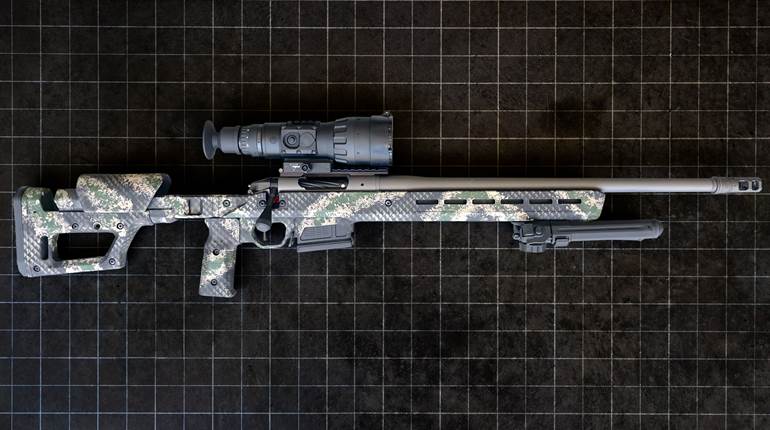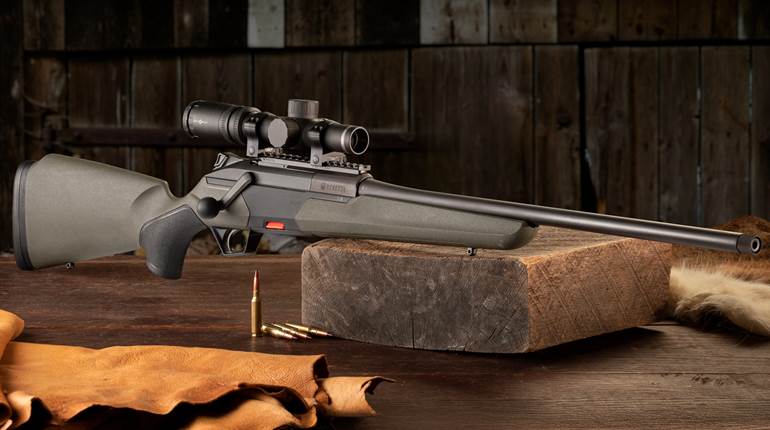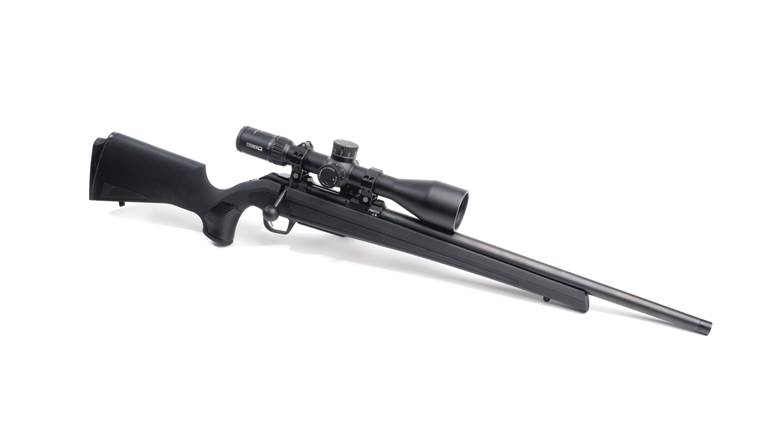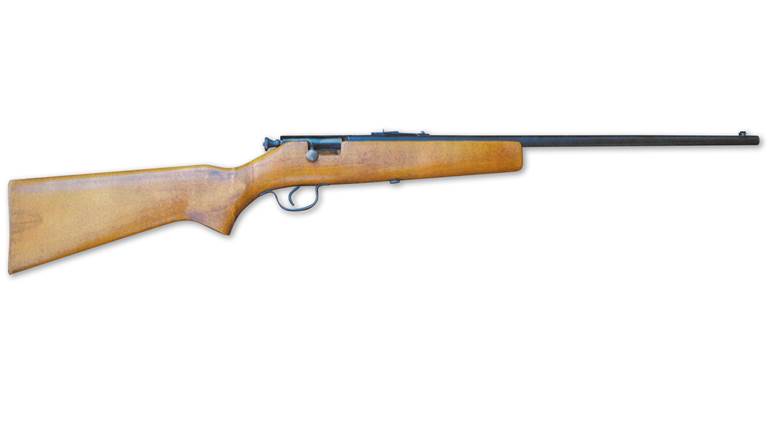
The Saphire Syn, shown here with a Burris Fullfield II 3-9X 40 mm scope in Burris Signature Zee rings, is suppressor-ready and comes with a thread protector.
For many riflemen, the name “Sabatti” conjures images of exquisitely crafted and equally expensive double rifles destined for the Dark Continent, and they wouldn’t be wrong. Nevertheless, the company also manufactures an array of arms for various sporting pursuits beyond the “Big Five,” one example being the subject of this review—the Saphire Syn.
Manufactured in Italy, the Saphire melds tradition and modernity. Nowhere is this more apparent than in the 25", cold-hammer-forged, 4140 steel barrel. Shooters who fancy open sights will rejoice at the inclusion of a drift-adjustable notch rear and post front, while non-purists can attach optics via the integral Picatinny rail segments atop the 7075 aluminum alloy receiver. Having both on hand can save a hunt. The muzzle is available with either a 1/2x28 or 5/8x24 TPI thread pattern, depending on the chambering, for adding a brake or suppressor, and a thread-protecting cap is provided for times when one isn’t used.
The Saphire features Sabatti’s unique Multi Radial Rifling (MRR). According to the company website, “Two different radiuses alternate in order to positively grip the bullet geometrically without submitting it to extreme stress. The specific rifling geometry of the forcing cone in MRR barrels makes it possible for the chamber neck and freebore to guide the bullets into the rifling more precisely and steadily than with the traditional rifling system.” Advertised benefits include higher velocities, tighter groups, fewer fliers, fewer copper deposits, easier cleaning and less barrel wear.
The Saphire Syn’s barrels are interchangeable, and so long as the cartridges are in the same “group”—matching the bolt head size and action length—it’s a straightforward swap. An example is switching from 6.5x55 mm Swede to 7x57 mm Mauser or .30-’06 Sprg. But, for exchanges outside of the group, the magazine, magazine box and bolt head might require replacement. Barrels and tools needed to perform the switch are available upon request.
Since lockup occurs between the bolt’s trio of lugs and the hardened, tempered, NiCrMo steel barrel extension, the receiver itself is only lightly stressed, so it has been machined from a block of aluminum alloy, rather than the more typical tubular steel. Projecting downward from the receiver’s front is a hearty recoil lug measuring 1¼"x1" and through which the front action screw passes. The single-stage trigger is mounted at the rear of the receiver, though a set trigger is an option, too. The sample rifle’s trigger broke with a 4-lb. pull. There was no discernible creep or overtravel.

Although the test rifle’s safety was a two-position side lever that locks the trigger and sear, as well as prevents the bolt from cycling for loading and unloading, reportedly a three-position safety will be available soon. Detents are both audible and tactilely positive. The bolt-release button is on the left, rear of the receiver. Feeding the Saphire is a detachable, single-stack, all-metal, three-round-capacity magazine, which is freed from the gun by pressing forward on the magazine-release button located within the trigger guard. One magazine is provided.
Consistent with other facets of the Saphire Syn, the full-diameter, three-lug bolt offers user customization. For instance, while the one–piece butterknife bolt handle was factory-installed, the sample rifle was also shipped with a standard handle and two knobs, including a large, tactical type. Benefits of the full-diameter bolt include smoother, bind-free cycling, while the three-lug design reduces bolt throw and speeds cycling. Extraction is by way of a sliding-plate extractor, and a plunger-type ejector sends cartridges wide of the gun.
A well-designed synthetic stock completes the gun. The angled, elevated comb quickens eye-to-sight and eye-to-optic alignment, while the large cheekpiece enhances cheekweld and increases comfort. To improve purchase, the fore-end has a reduced-diameter upper portion and checkering, while the pistol grip only has the latter. The entire surface has a slightly tacky feel. There are dual sling swivel studs (with swivels provided), and the butt has a cushy recoil pad.
Consistent with American Rifleman protocol, we tested the sample Saphire Syn, chambered in .308 Win., from a sandbag rest at 100 yds. using three loads and firing five consecutive, five-shot groups with each. Two hunting loads and a match load were selected for the test. To give the rifle a fair shake, we opted to forgo the open sights; instead, we mounted a Leupold VX-3i 4.5-14X 40 mm scope in Weaver Tactical rings. The full results are tabulated nearby; suffice it to say that the Saphire performed well.
The Hornady Precision Hunter ammunition edged out the Nosler load, and the single smallest group—measuring a scant 0.57"—was created using Grand Island’s finest. During testing, there were no failures of any kind, and despite the barrel being hands-off hot for the majority of the test, it still grouped well. The excellent trigger assuredly played a role as well. Interestingly, despite the barrel heat, bullet impacts didn’t rise with each subsequent shot, rather they simply enlarged outwardly.

For a .308 Win.-chambered rifle, the Saphire Syn’s 25" barrel is atypical, but the extra velocity it afforded was most welcome. In fact, the loads approached or equalled the factory-published numbers, which would translate to superior external and terminal ballistics in the field. Moreover, in shooting the test rifle more than 125 times in a single sitting, we discovered the skill with which the stock and recoil pad were designed, as we didn’t feel any discomfort. Not that the .308 Win. generates particularly harsh recoil, but this is not a heavy rifle, and the cumulative effect can add up.

We didn’t find anything about the rifle we’d change, though it did take time to get used to the magazine-release button/detachable-box magazine combination. In most hunting rifles, a similarly positioned magazine-release button releases a hinged floorplate, so you’ll need to retrain your brain to grab the freed magazine. The Saphire Syn is evidence that Sabatti isn’t a one-trick pony. It’s also evidence that quality and thoughtfulness with regard to design transcend price, as the model offers a lot of rifle for the money. It could aptly be termed a “gem.”





































